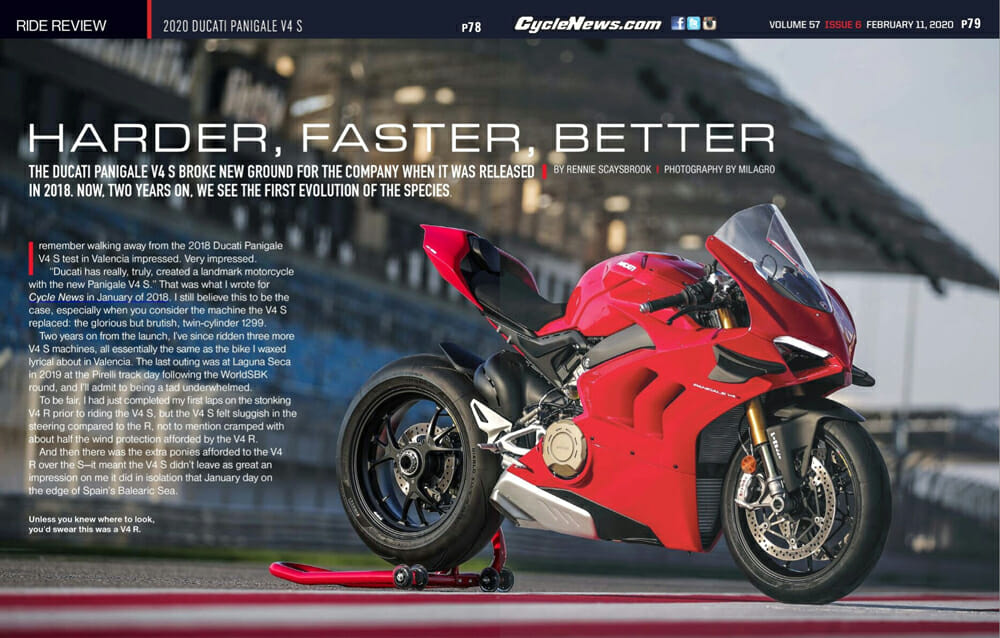Rennie Scaysbrook | February 13, 2020
The Ducati Panigale V4 S broke new ground for the company when it was released in 2018. Now, two years on, we see the first evolution of the species.
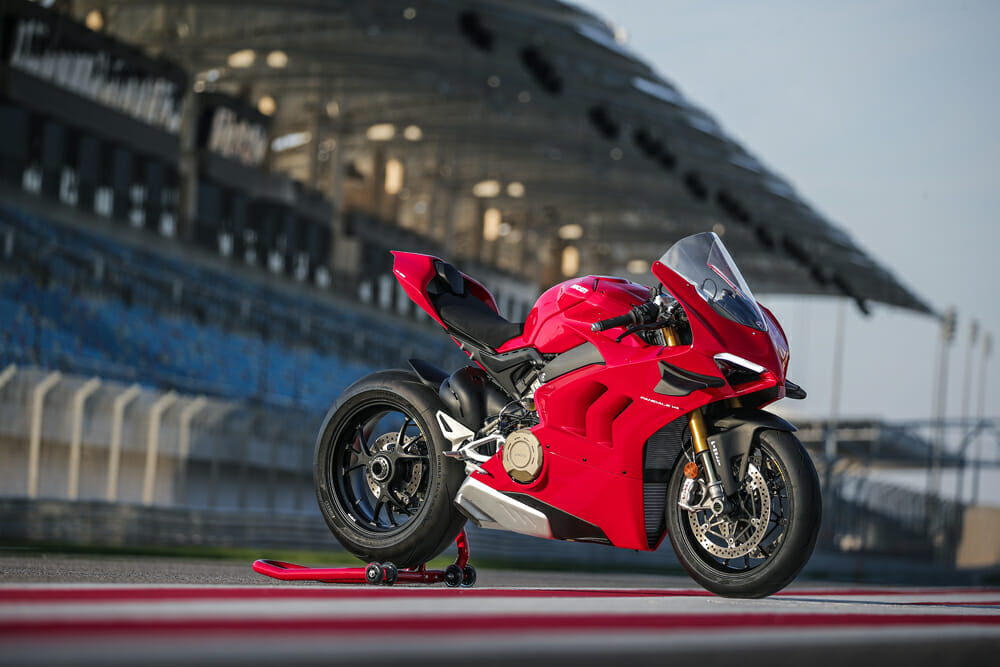 Unless you knew where to look, you’d swear this was a V4 R.
Unless you knew where to look, you’d swear this was a V4 R.
Photography by Milagro
I remember walking away from the 2018 Ducati Panigale V4 S test in Valencia impressed. Very impressed.
“Ducati has really, truly, created a landmark motorcycle with the new Panigale V4 S.” That was what I wrote for Cycle News in January of 2018 in the 2018 Ducati Panigale V4S Review. I still believe this to be the case, especially when you consider the machine the V4 S replaced in the glorious but brutish, twin-cylinder 1299.
Two years on from the launch, I’ve since ridden three more V4 S machines, all essentially the same as the bike I waxed lyrical about in Valencia. The last outing was at Laguna Seca in 2019 at the Pirelli track day following the WorldSBK round, and I’ll admit to being a tad underwhelmed.
To be fair, I had just completed my first laps on the stonking V4 R prior to riding the V4 S, but the V4 S felt sluggish in the steering compared to the R, not to mention cramped with about half the wind protection afforded by the V4 R.
And then there was the extra ponies afforded to the V4 R over the S—it meant the V4 S didn’t leave as great an impression on me it did in isolation that January day on the edge of Spain’s Balearic Sea.
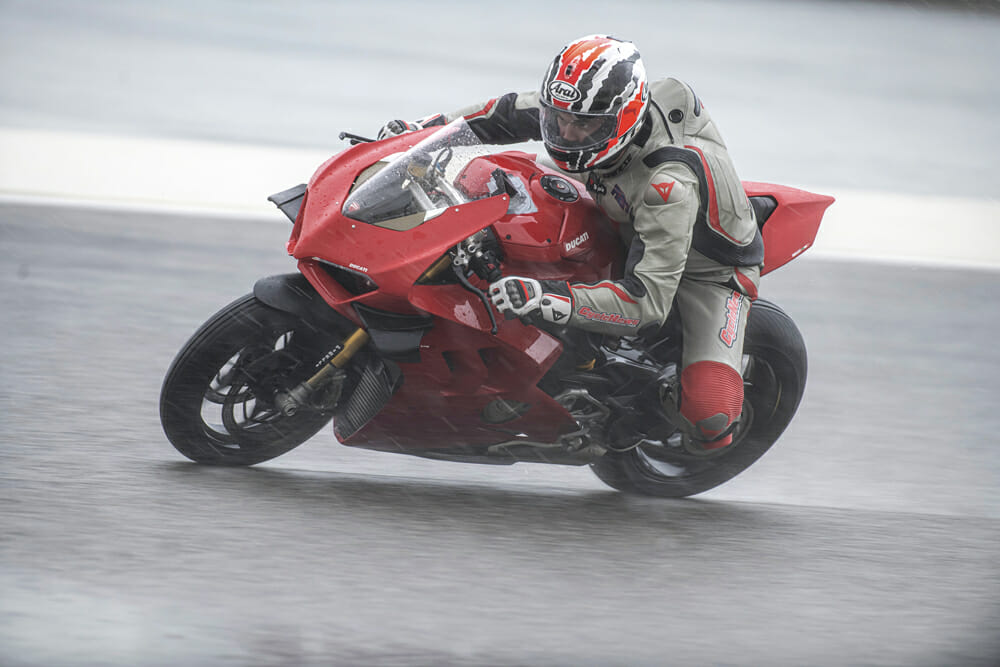 The rain in Bahrain may have been unexpected but it gave us a chance to evaluate Ducati’s changes under a bigger microscope than normal.
The rain in Bahrain may have been unexpected but it gave us a chance to evaluate Ducati’s changes under a bigger microscope than normal.
2020 Ducati Panigale V4 S Review | Making it Right
Two years used to be a huge amount of time in motorcycle development. Now we’re looking at up to 10 years (as is the case with some manufacturers) before we see big improvements or changes, so it came as a surprise when, at a special pre-EICMA presentation last year, Ducati unveiled what looked like a V4 S in V4 R drag.
The 2020 Ducati Panigale V4 S and the V4 R now look like twins, with the former stealing the latter’s bodywork, including new aerodynamic winglets aside the fairing.
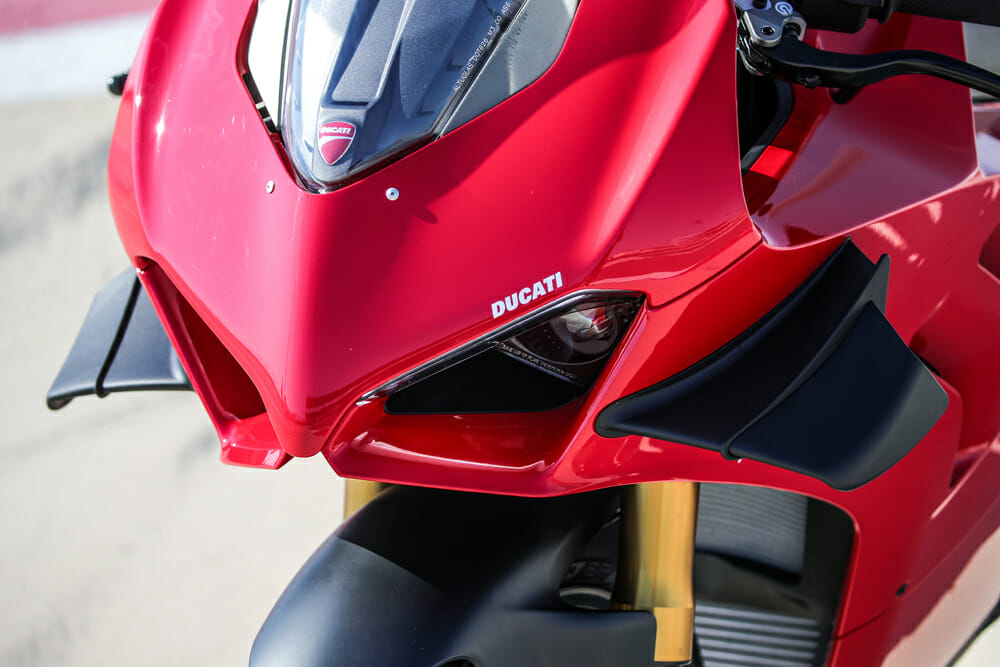 Aerodynamic winglets add significant downforce and give street cred other bikes would die for.
Aerodynamic winglets add significant downforce and give street cred other bikes would die for.
The V4 S further raided the V4 R’s parts bin by using a similar, although not totally identical, front frame that offers a massive 30 percent increase in torsional (twisting) stiffness and a 15 percent increase in braking (fore and aft) stiffness.
Let’s focus on the most obvious thing first.
The new V4 S fairing gives the motorcycle exponentially more downforce the higher the speed. Sounds obvious, right? The best explanation I can give goes to KTM’s MotoGP Technical Director Sebastian Reiss. When I asked him last year at COTA about the little scoop under the Ducati MotoGP bikes that Ducati Corse boss Gigi Dall’Igna said was to “cool the rear tire,” rather than add downforce, Reiss simply said, “travel at 40 mph in a car, and stick your hand flat out the window. Now turn your hand so it’s 45° to the ground. There’s your downforce.”
For the V4 S rider, there’s now a claimed potential 81 pounds of downforce at 186 mph thanks to the two side winglets. On the sliding scale, at a more legal 62 mph, you’ll get 8.8 pounds of downforce pushing down on the front wheel, helping that tire stay in contact with the road and stay partially loaded for when you hit the brakes.
At a sadly soaking wet Bahrain International Circuit, where the average rainfall for the region is about 2.8 inches, we got about two inches in one day. No one could believe it. But the drenched track conditions put even more of an emphasis on the Ducati’s stability, especially given the indicated 185 mph speeds reached down a front straight that even maxes out Formula One cars.
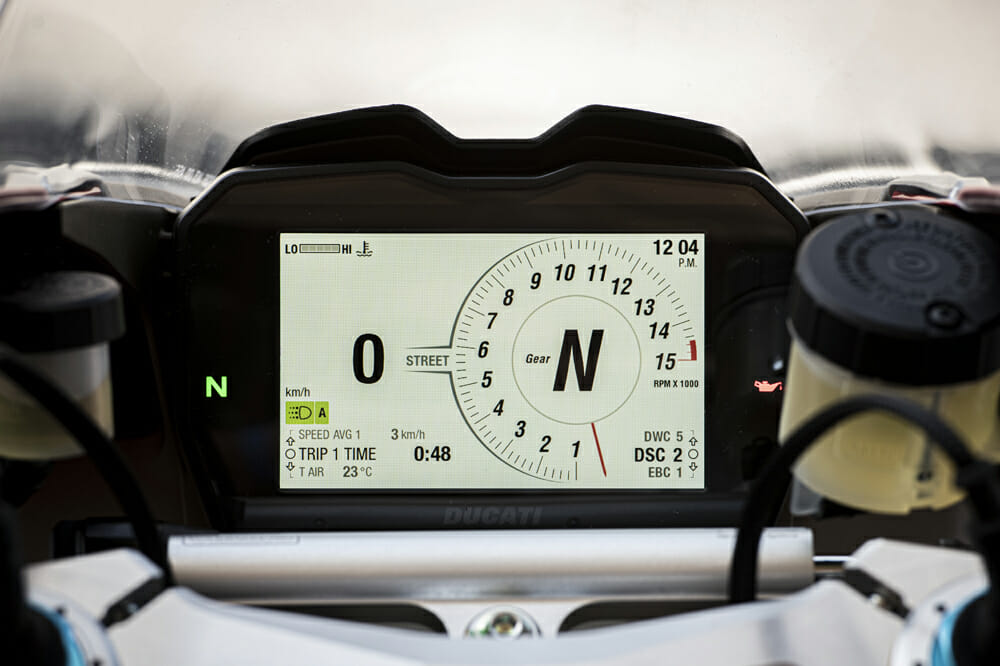 Base mode for the V4 S dash…
Base mode for the V4 S dash…
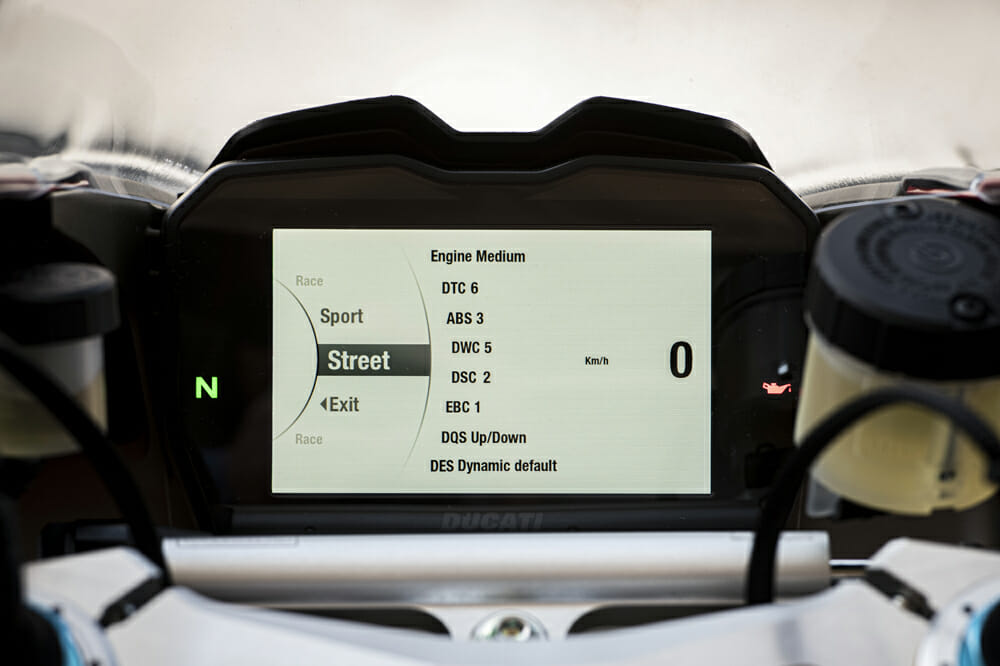 And then into just one area. Each parameter you see here is adjustable. You can almost get lost in how much scope you have to play with.
And then into just one area. Each parameter you see here is adjustable. You can almost get lost in how much scope you have to play with.
The wings offer two distinct advantages. The first and most obvious is the increased downforce at high speed makes for greater stability, especially when you hit the brakes. Having weight on the front tire means one part of the braking phase is essentially done for you, allowing you to further set yourself up for the approaching corner, and hit that apex easier.
The second and less obvious benefit is as the speed increases, electronic intervention in the form of wheelie control is reduced, thus allowing you to keep on the gas for longer without the ignition cutting and you losing drive. It’s a win-win.
The new V4 S looks physically beefier than the old model, which is mainly due to the V4 R-derived front fairing being 15mm wider each side, and the side fairings wider by a substantial 38mm left and right. Pair these changes with the same screen as the V4 R, one that’s taller by 34mm, and the V4 S becomes a much easier bike to tuck in on, especially if you’re above six feet tall.
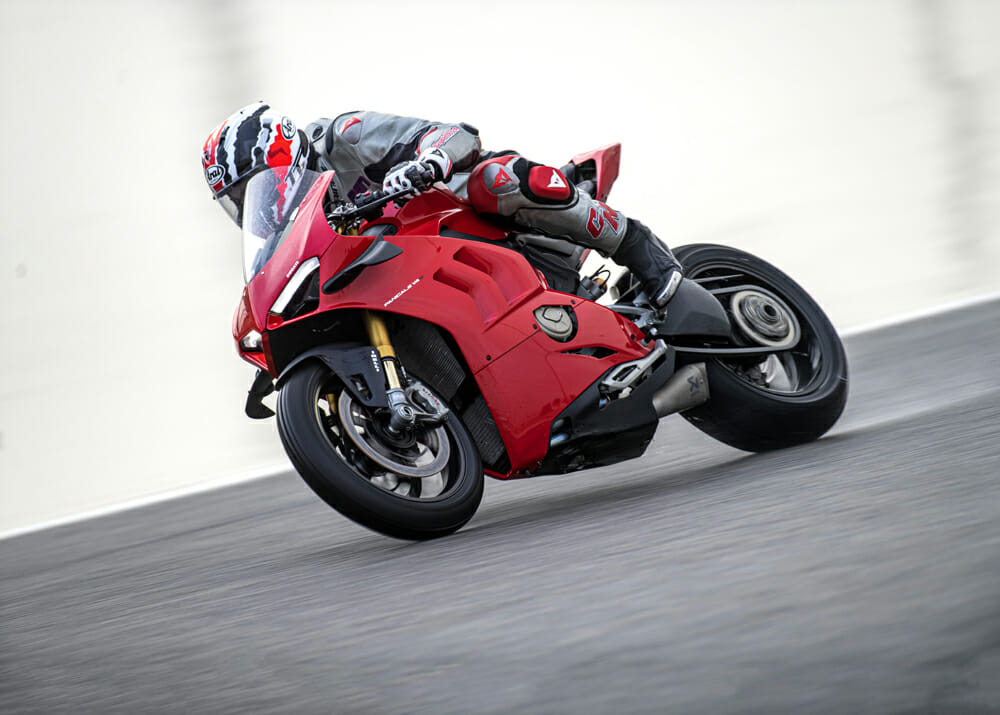 Rennie got two sessions on the hot Panigale, equipped with the full titanium Akrapovic exhaust and mapping that lets the motorcycle have its full 226 horsepower head. Yes, the ride is damn fast, but it’s also supremely smooth, with a nicer connection at the throttle than the base model Panigale he rode for the majority of the test.
Rennie got two sessions on the hot Panigale, equipped with the full titanium Akrapovic exhaust and mapping that lets the motorcycle have its full 226 horsepower head. Yes, the ride is damn fast, but it’s also supremely smooth, with a nicer connection at the throttle than the base model Panigale he rode for the majority of the test.
2020 Ducati Panigale V4 S Review | Soft is Good
Moving onto the chassis, Ducati further improved the V4 S by running softer front springs (we don’t know exactly what rate), while increasing the stiffness of the V4 R-derived front frame.
The reasoning behind is simple. On the street, you need compliance, read: softer suspension. If you’ve ever ridden a racebike on the road, it’s (usually) a terrible experience. Compliance from the suspension means you don’t get bashed around every time you hit a crack in the road and allows the tire and chassis to soak up any issues you may encounter while cranked over.
The flip side of this is if you go too soft, the bike wallows around, won’t hold its line, and runs wide when you get on the gas, so it’s always a compromise.
As such, Ducati’s fitted softer springs front and rear with more preload, rather than the other way around (stiffer springs, less preload), which gives the bike a nicer feel on the side of the tire and allows the suspension more room to do its thing, rather than being tightly wound up like with stiffer front and rear springs.
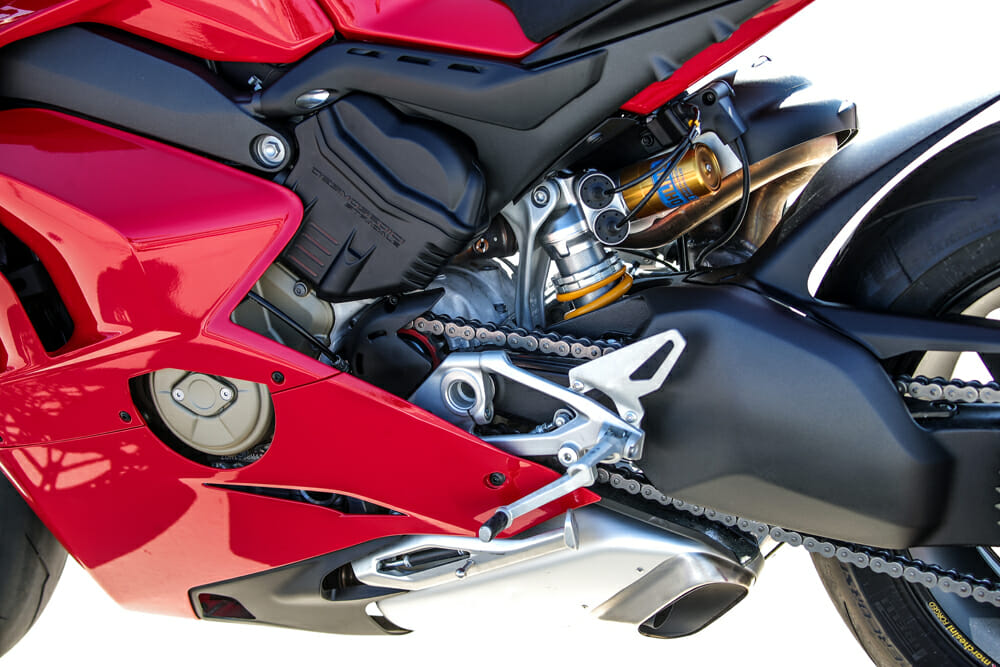 Plenty of horsepower, approximately 214, lurk beneath the now-winged fairing.
Plenty of horsepower, approximately 214, lurk beneath the now-winged fairing.
Panigale’s have never been considered comfortable street bikes. They are hard-edged, track-focused weapons, but it’s nice to ride one to the shops every now and then. Again, the rain in Bahrain allowed for this softer setup to really shine, because in the wet you want soft, anyway. The track conditions made it impossible for me to give you a like-for-like comparison to the 2018 model (the Valencia test was run in brilliant sunshine) but the overall feeling, at least at my sedate pace, was of a bike that didn’t wear the rider out to quite the degree the 2018 model would.
The electronic Ӧhlins Smart EC2 suspension is the same from the 2018 mode, no changes there. But the springs bring with it a 5mm taller ride height front and rear, with the center of gravity and seat height also up five millimeters. The softer setup naturally gives the bike more forward and rearward pitch, which is fine up until it’s too much and the suspension is maxed out. I think most will never reach this level on the road, let alone the track.
As for the shock itself, it’s now five millimeters longer than in 2018, with the rear linkage length reduced also by five millimeters. The fork breaks the five-millimeter-mold by being raised four millimeters, with the motor now sitting five millimeters higher in the front frame chassis.
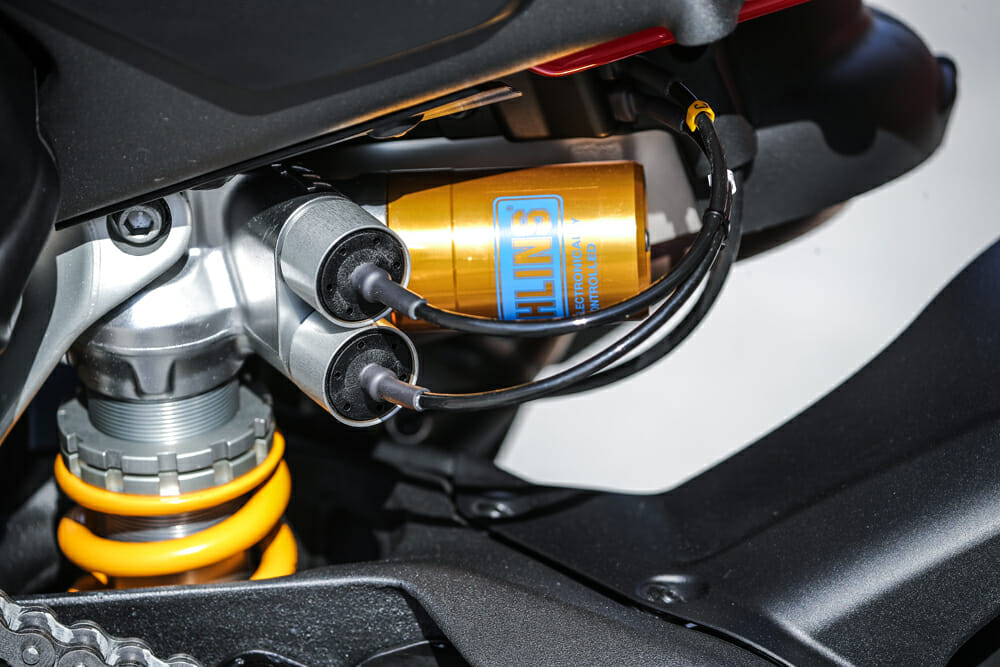 Ӧhlins suspension is essentially unchanged as far as the electronics are concerned, but the spring is softer.
Ӧhlins suspension is essentially unchanged as far as the electronics are concerned, but the spring is softer.
2020 Ducati Panigale V4 S Review | Max drive, all the time
For any motorcycle measuring 200-plus horsepower, top of the priority list should be being able to actually use it. Ducati said its 2018 model was a bit of a beast (no argument here), so for 2020 the electronics boffins have sunk their teeth into the V4 S and revised the torque settings in the first three gears, and played around with the TC.
What they’ve done is adjust the torque in the first three gears to match the amount of acceleration with the wheelie limit, so you don’t get too much thrust that the front is never on the ground and the wheelie control keeps kicking in. Here you can see the link between the hardware (wings) and the software, as both systems are trying to keep the front wheel on the ground and maintain maximum drive.
The initial phase of the throttle opening is not as abrupt as in the 2018 model, which was a nice benefit when dealing with the soaking track conditions in Bahrain. When cranked right over in a low gear at low rpm, when the torque hit is at its most violent, the 2020 Panigale would drive forward with a smoother throttle pick-up than before, which gives with it the added benefit of better traction, less electronic intervention and better chassis stability, allowing you to fully maximize the grip available.
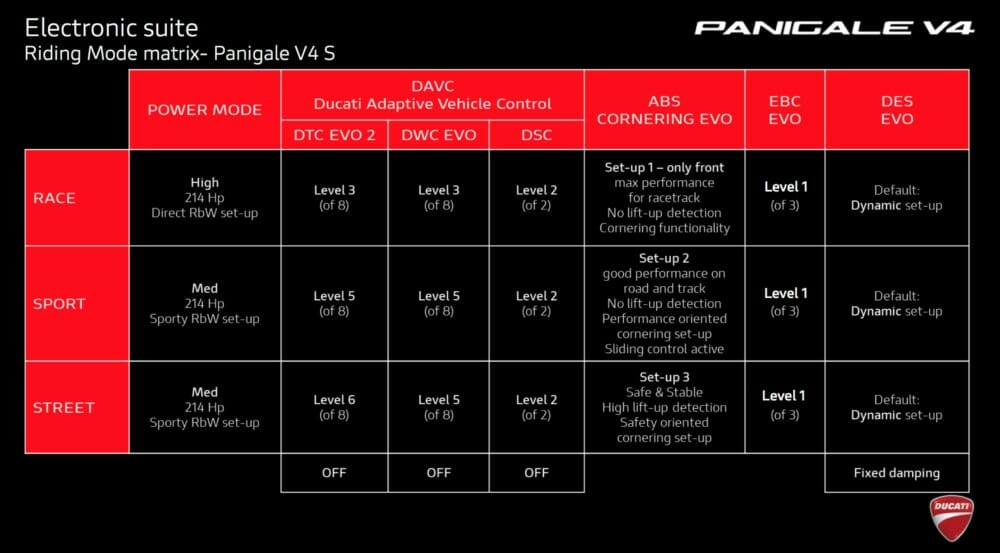 This gives you a brief outline of which modes are equipped with what settings across all parameters.
This gives you a brief outline of which modes are equipped with what settings across all parameters.
The electronics are only partially new for 2020. Cornering ABS, Slide Control, Wheelie Control, Power Launch, Engine Brake Control and the Ducati Electronic Suspension are all the same as before, with the Ducati Quick Shift Up/Down gear shift and more importantly, the Ducati Traction Control (DTC) new for this year.
The DTC EVO 2 is a predictive system and senses when a wheel starts sliding, if it’s going to continue to slide. The DTC EVO 2 intervention is faster than before, but it’s also not as violent, reducing the torque in a more linear fashion to maintain as much forward drive as possible, as smoothly as possible.
The feeling at the twist grip is divine, and a true indication of just how good the TC systems really are these days, not just the Ducati system. Coming onto the back straight, with over 200 horsepower beneath my loins on a soaking wet track, you could go from nothing to full throttle with the bike almost upright (the DTC EVO 2 is a lean angle-sensitive system, after all), and the electronics would sort the rest out. There’d be lights flashing everywhere on the dash, but you’d be safe.
To do that six or seven years ago would send me flying so far, I’d probably not need the Emirates ticket to get back home.
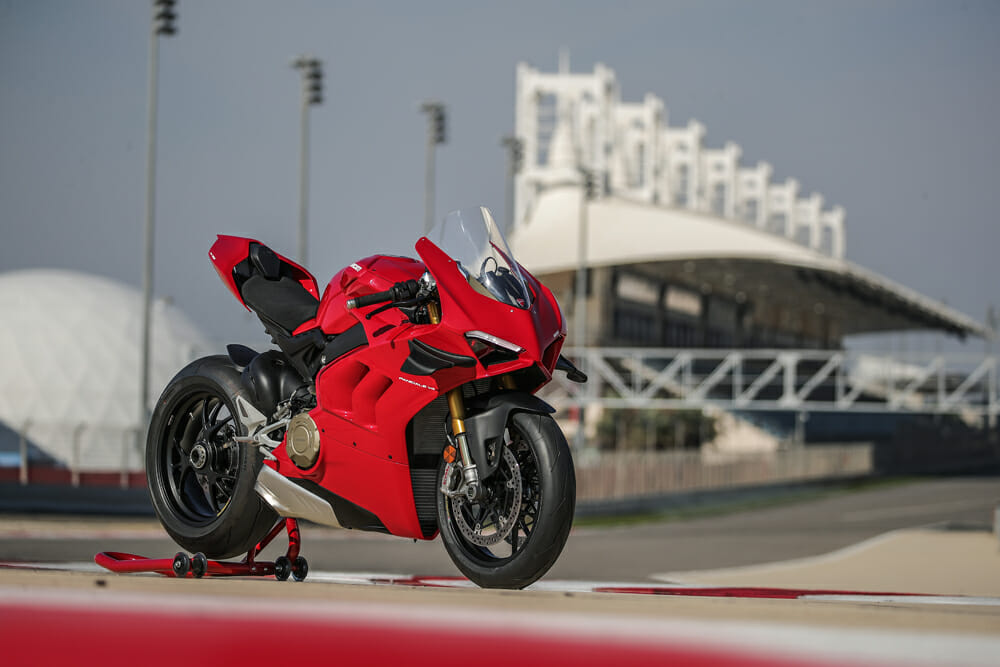
2020 Ducati Panigale V4 S Review | The Rain in Bahrain
The staff at Ducati almost had tears in their eyes at breakfast. Here we were, with a Formula One circuit, in the middle of the Arab desert, and it was pissing down with rain. If you could have predicted this, perhaps predicting lottery numbers would be a good vocation.
Still, the rain brought with it the chance to sample much of what Ducati claims for the 2020 V4 S under a microscope, namely the stability offered by the aero, the more compliant suspension and that glorious traction control.
Straight up, I only rode at about 60 percent pace in Bahrain. For the majority of the day it was so wet, and I wasn’t about to become the only journo to trash at V4 S by trying to be a hero. As such, I’ll reserve absolute final judgement on the new V4 S until I’ve ridden it in anger, in the dry, on the track.
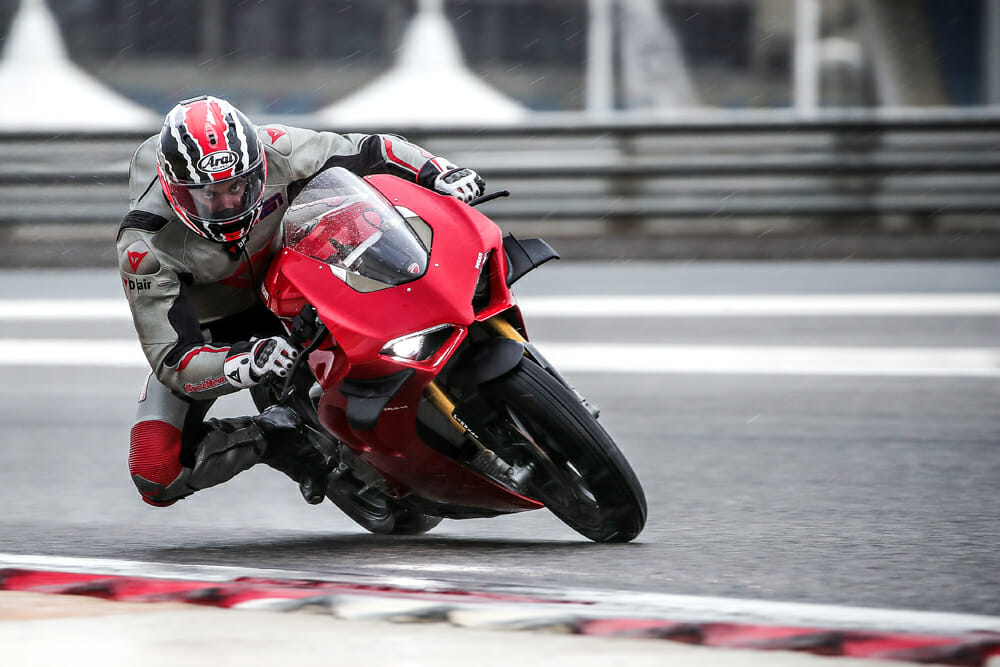 Mid-corner stability is excellent in the wet. Now to take it to California and test it in the dry.
Mid-corner stability is excellent in the wet. Now to take it to California and test it in the dry.
What I can tell you is at over 180 mph, the V4 S was solid as a rock. Not fidgety movements from the front, the Panigale was a wet, red guided missile, and it was easy to see this as being the main difference to the 2018 model. Combined with the softer suspension, in the wet the ride was beautiful. I suspect the Panigale’s street manners will be much improved, and the bike more accessible to a wider range of skill sets than previously.
Even at my wet pace, the Panigale just felt easier to ride, it’s as simple as that. Don’t get me wrong, you still need to be on your toes, this is a 1103cc V4 superbike you’re on, after all, but the intimidation factor has been ratcheted down a notch or two. Trust me, that’s a good thing.
The 2020 Panigale tips into corners smoothly and precisely, and the wings give it a bit of extra weight and thus stability when you’re in them. Move towards the end of the mid-corner phase as you wind on the throttle, and the softer throttle response belies the fact you’ve got such horsepower beneath you. The 1299 could only dream of this level of smoothness and driveability.
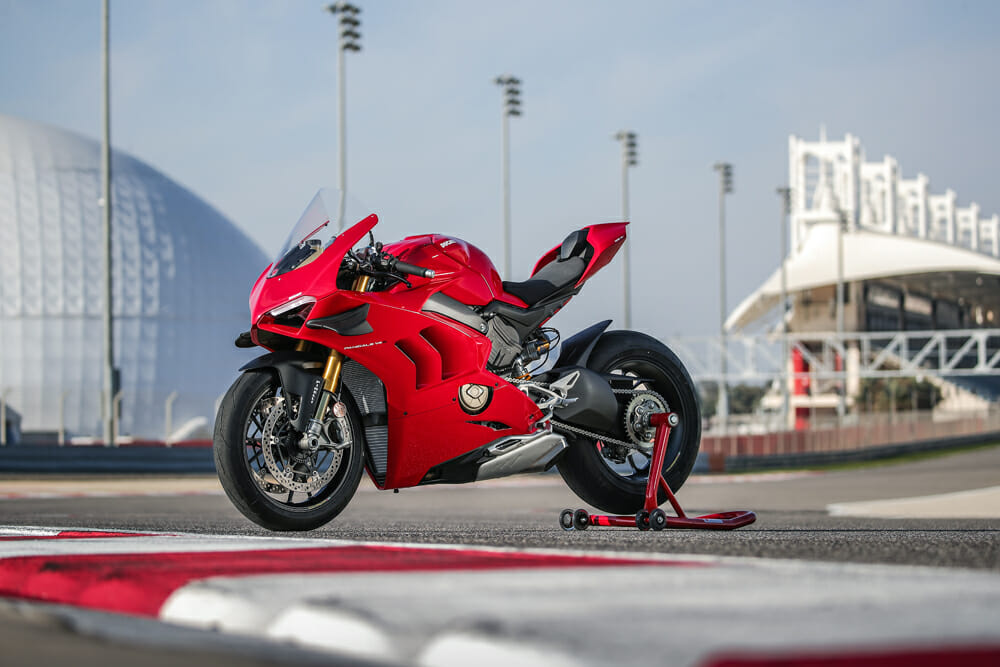 Under $30K brings with it a level of performance on par with many supercars 10 times the price.
Under $30K brings with it a level of performance on par with many supercars 10 times the price.
I have already put my request in for a 2020 Ducati Panigale V4 S, some California sunshine and a couple of sessions at Fontana Speedway to truly evaluate the changes wrought on Bologna’s finest. From the hot seat in the wet, the feeling is of a more neutral, easy-handling motorcycle, with power to shred and looks to kill, and I suspect the feeling will only be amped up in the dry.
One thing I can tell you, more riders will be able to get more out of the Panigale. It’s still a beast, but without the slightly nervous energy of its predecessor.CN
VIDEO | 2020 Ducati Panigale V4 S World Launch and Review

2020 Ducati Panigale V4 S Specifications
| MSRP: |
$28,395 |
| Engine: |
Desmosedici Stradale 90° V4, rearward-rotating crankshaft, 4 Desmodromically actuated valves per cylinder, liquid-cooled |
| Displacement: |
1103cc |
| Bore x stroke: |
81 x 53.5mm |
| Fuel injection: |
EFI, twin injectors per cylinder. Full ride-by-wire elliptical throttle bodies, variable-length intake system |
| Compression ratio: |
14.0:1 |
| Power (claimed): |
214 hp at 13,000 rpm |
| Torque (claimed): |
91.5 ft.-lbs. at 10,000 rpm |
| Exhaust: |
4-2-1-2 |
| Transmission: |
6-speed with Ducati Quick Shift (DQS) up/down EVO 2 |
| Clutch: |
Hydraulically controlled slipper and self-servo wet multi-plate clutch |
| Electronics: |
Ducati Traction Control (DTC) Engine Brake Control EVO (EBC EVO), Ducati Electronic Suspension EVO (DES EVO), Cornering ABS EVO, Ducati Wheelie Control EVO (DWC EVO), Ducati Slide Control (DSC) |
| Chassis: |
Aluminum alloy front frame |
| Front suspension: |
Öhlins NIX30 43mm fully adjustable fork with TiN treatment, electronic compression and rebound damping adjustment with Öhlins Smart EC 2.0 event-based mode |
| Rear suspension: |
Fully adjustable Öhlins TTX36 unit, electronic compression and rebound damping adjustment with Öhlins Smart EC 2.0 event-based mode, aluminum single-sided swingarm |
| Front brake: |
2 330mm semi-floating discs, radially mounted Brembo Monobloc Stylema (M4.30) 4-piston calipers with Bosch Cornering ABS EVO |
| Rear brake: |
245mm disc, 2-piston caliper with Bosch Cornering ABS EVO |
| Front tire: |
Pirelli Diablo Supercorsa SP 120/70 ZR17 |
| Rear tire: |
Pirelli Diablo Supercorsa SP 200/60 ZR17 |
| Rake: |
24.5° |
| Wheelbase: |
57.8 in. |
| Seat height: |
32.48 in. |
| Fuel capacity: |
4.23 gal |
| Weight (dry, claimed): |
384 lbs. |
